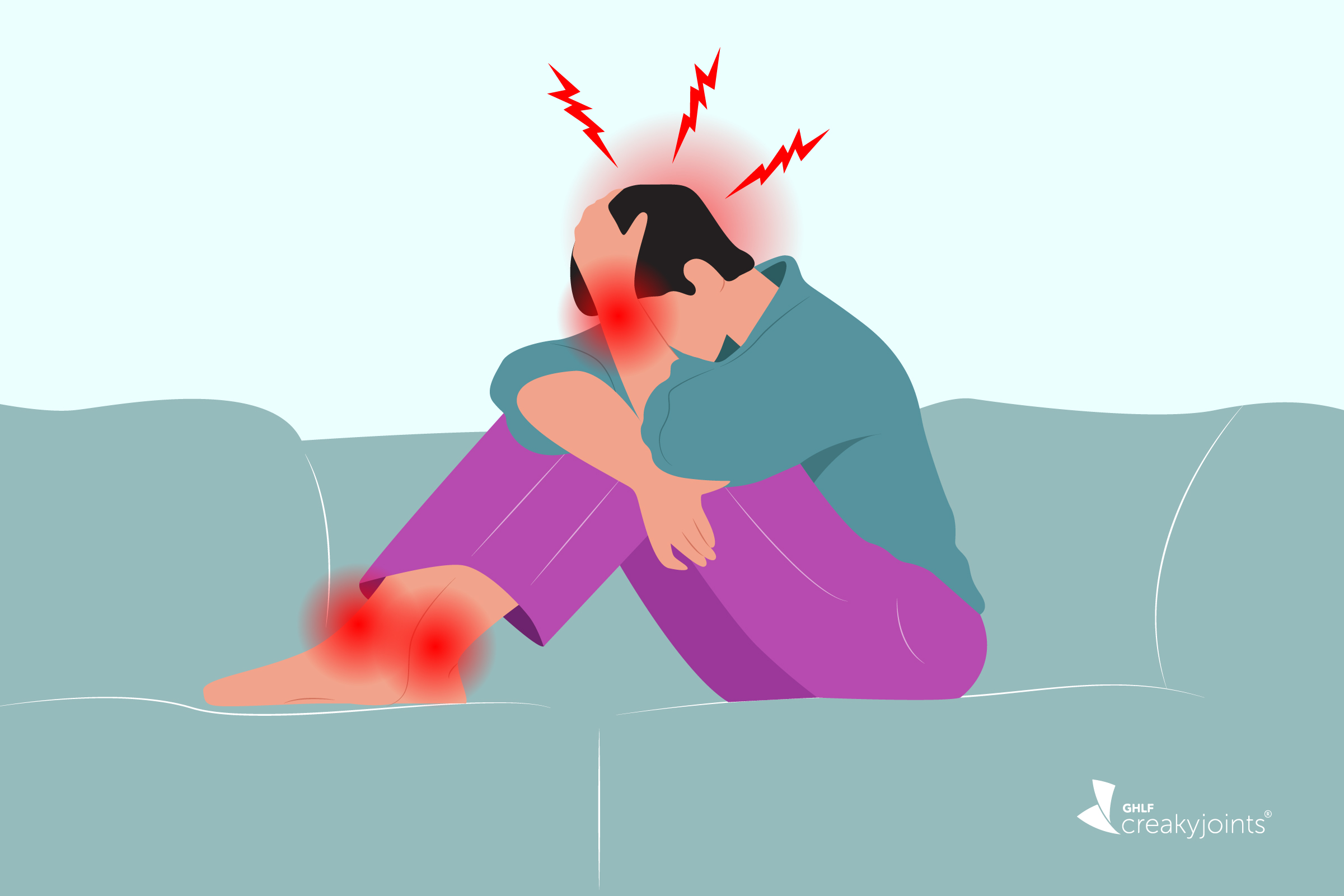The Up-End Migraine Project reveals key gaps in episodic migraine care, aiming to drive change and improve treatment options for patients through insights from both providers and patients.
“Everyone Deserves Space That’s Comfortable.” How an Interior Designer with Chronic Migraine is Making Disability-Friendly Spaces for Others
“EVERYONE DESERVES A SPACE THAT’S COMFORTABLE.” HOW AN INTERIOR DESIGNER WITH CHRONIC MIGRAINE IS MAKING DISABILITY-FRIENDLY SPACES FOR OTHERS
August 25, 2021
Rachel Ellis

This story was told to Global Healthy Living Foundation by Alex Tomlinson, a 23-year-old student of interior design who lives in Wisconsin with her family.
Here is Alex’s story about her life with chronic migraine and psoriatic arthritis and how she hopes to use her experience to help create disability-friendly spaces for others dealing with their own chronic conditions.
I’ve had migraine attacks my whole life. The first incident in my memory was in elementary school. I remember not being able to read a textbook so, to solve the problem, my teachers moved my seat. They thought it might be a glare getting in the way of my vision. But the problem continued.
I went to an eye doctor and suddenly there I was, the only fifth grader with bifocals. Finally, after a year I convinced the adults in my life that I could see just fine and was able to drop the glasses. But it wasn’t until middle school that the pieces fell together, and my doctors realized the problem wasn’t my vision — it was migraine.
My mom had migraine, so there was a family history. But because only 10 percent of kids age 5 to 15 get migraine, it probably wasn’t at the top of the doctor’s diagnostic list. Additionally, my earliest bouts of migraine were the abdominal types — ones that cause stomach pain, nausea, and vomiting — so the diagnosis wasn’t as obvious. I did, however, have difficult focusing my eyes, which is a common migraine symptom. When this happens, everything can feel distorted, almost like an out of body experience.
Navigating the Teen Years with Chronic Migraine
It wasn’t until high school that I started having head pain that interfered with my daily life. I started on my first medication my freshman year (an antidepressant that is used to treat migraine). I also took a hormonal birth control shot, which is sometimes used to manage migraine.
Sometimes I would have to call mom to pick me up from school and I would go home and get really sick. But I didn’t miss much school, even as the migraine attacks got worse during my junior year. I remember telling my parents I’d just take my medicine first thing in the morning, skip first period, and go back to sleep while it kicked in. Then I’d get up and go to school for the rest of the day. It was how I made it through high school.
I also had some key support. One teacher was absolutely amazing. She said, “I’m the kind of teacher who isn’t going to ask questions. If you need to put your head down during class, you do what you need to do.” This was the first time I felt like someone got it without me having to say something.
I met my best friend, who also has migraine, at a waitressing job during my senior year. Though her condition is not quite as severe as mine, that entire summer we’d take turns taking care of each other through the pain.
The Quest for Relief
At the very end of my senior year, I started having migraine attacks every single day. I tried a lot of different therapies. But no matter what magic cure I tried, I constantly ended up in the emergency room — once during a college visit — and it was terrifying.
Part of the issue is that the medications that are supposed to stop migraine attacks while you’re having them — known as abortive medications — don’t always work for me. My migraine attacks will reach a point where my whole body just shakes, I feel my blood pressure dropping, and I get nauseous. The goal of most migraine treatment is to keep you out of the emergency room, but sometimes I felt like I just had to get to the ER because they can give you fluids and steroid shots to help reduce the pain. Sometimes they’d give me a mix with Benadryl so I could go to sleep.
Right after high school my migraines were deemed intractable — they didn’t stop. And it was the scariest experience of my life. I was eating my migraine pills like candy to cope with the constant pain. I had no local medical support, or access to adequate medical care. But the hardest part was not having the right words to explain what was happening. When your body is rejecting food for months and you’re experiencing a disease that no one else around you understands, terrifying is truly the only word that I think encompasses that experience.
It was difficult and got more challenging when I started college. My freshman year roommate didn’t like that I wouldn’t go to parties with her. She didn’t understand that I was on a new migraine medication, and drinking alcohol wasn’t safe. (Not to mention alcohol can make migraine much worse.) I could have forgone the booze and tagged along, but who wants to be the only sober person at a frat party?
Now, five years later, I’ve settled into a combination treatment. I use an anti-seizure medication as my daily preventive treatment. I’ve had an off-again-on-again relationship with it as I’ve tried to figure out how and if it works for me. At one point, I realized I was overusing the medication and experiencing a phenomenon known as medication overuse headache, which is when a headache occurs 15 or more days a month as a result of regularly taking too much of a headache medication. It took a couple more years to better understand how this medication worked for (and against) me, and it is the only medication that provides any sort of regular comfort. For abortive treatments — to stop a migraine attack that is currently happening — I alternate between a new oral medicine that targets a protein called CGRP, which plays a role in migraine, and Benadryl.
Even with this treatment plan, I still have some migraine symptoms essentially every day, whether that be head pain, nausea, vertigo, difficulty concentrating, irritation, or extreme sensitivity to sound.
Another Chronic Illness Enters the Picture
As if dealing with migraine wasn’t enough, I was diagnosed with psoriatic arthritis last year — in the middle of the pandemic.
In retrospect, I probably showed signs of arthritis in high school. My joints wouldn’t quite feel right, and they’d hurt for a long time. But it wasn’t until last February that I thought to do something about it. One night, I put my thumb to my forefinger before bed and felt an electric shock. I did it a couple more times to confirm what I was feeling but couldn’t figure out the cause. It happened again the next night. Eventually, my hand swelled to the point where I couldn’t straighten it.
I brought it up to my neurologist, and he sent me for X-rays to confirm that it wasn’t a compressed nerve. He suggested I follow up with a rheumatologist. But then the entire world shut down and my family moved from Charleston, South Carolina to Wisconsin. Suffice to say, finding a rheumatologist became difficult.
When I finally was able to see one, I learned that I had psoriatic arthritis — and that I’d been living with undiagnosed psoriasis for years. I used to ask doctors about a weird patch on my nose, and they’d shrug it off and just tell me to stop picking at it. I think I probably asked about 12 different doctors about various scabbed places on my nose and in my ears. Turns out, those were psoriasis plaques.
It’s been a whole other journey to find the right rheumatologist and treatment plan for me — and I’m still working on it.
Designing for Disability
Before I had to go on disability for my chronic conditions, I was in school for interior design. While there, I was given a class project where we had to design a condo for someone who used a wheelchair. We had to give our subject a backstory, so I decided that in addition to being in a wheelchair, my person also had chronic migraine. At the time I was super sick, so migraine was always on my mind.
I included things like blackout curtains, dimmable lights, and rooms that didn’t necessarily have windows — places where you could utilize soothing elements like aromatherapy and music to help you relax and ease the tension of a migraine.
As I left school and the workforce due to my disability, I started to consider how I could give back to the rest of the migraine community. I realized I could help people create spaces that would offer a respite as they dealt with whatever chronic condition they have.
My availability is extremely limited because of my chronic illnesses, but when I’m able to take on a client, I get them to focus on what they need. I ask them to tell me about their lifestyle and their illness. I ask about any sensitivity to light, vision changes, or issues with glare. I find these are things that most designers don’t think about because they don’t have to deal with it on a daily basis. My goal is to think about all elements of life, particularly for those whose lives are spent in chronic pain. I want to make design inclusive and welcoming to everyone, because everyone deserves space that’s comfortable.
Connecting with Others
When I was growing up, I spent forever scouring the internet for any migraine information. I couldn’t find much, and I couldn’t find anything geared toward someone my age. I could find tips for adults, but I needed advice for things like living in a dorm room with migraine. Now, I’m working on becoming the resource my younger self needed.
One of the most important things that I have done in my chronic illness journey is start my blog, My Life. My Migraine. It began as a therapeutic space to talk about how no one understands migraine. Then it shifted into a space where I could educate others: I could talk about life with migraine, the disability process, and other important things to know. I now have an entire page of specific resources on a variety of migraine and disability topics.
I also use social media sites, like Twitter and Instagram, to connect with other people who have migraine. We talk about our shared experience and provide practical solutions to migraine-specific issues. For example, I once suggested someone pop a breath mint while sitting in a meeting to help with nausea. It’s gratifying to see people comment, “Oh my gosh, I can sit through meetings and not have to worry about getting sick anymore!”
My Tips for Creating a Migraine- and Chronic Pain-Friendly Home
Take a good look at what you have. Do you have good places where you can lie down or sit? Do you have a space that can be quiet? Could curtains or dimmable lights help lower the lighting? Assess your space and see what you can make work better for you.
Work with the people you live with. Talk to roommates or family members about how you can adapt and adjust a space to make things more comfortable for you. Sometimes you may have to deem certain spaces are quiet-only so that it’s clear where you can go for respite.
Prioritize comfort. Sometimes things look pretty, but you need to ask if they’re also practical. And in some cases, you may need prioritize function over fashion. My papasan chair, for example, is the most comfortable chair ever, but it doesn’t necessarily look like something an interior designer would choose. And that’s okay, because the most important thing is that your items — and the space they reside in — are comfortable for you.
My Advice for Others Dealing with Chronic Illness
Familiarize yourself with your needs and your boundaries — and honor them. This may require you to be uncompromising when people insist on pushing you too far out of your comfort zone. You may lose people you care about simply because they don’t respect your needs. But the moment you begin recognizing your own boundaries you’ll find yourself surrounded by other people who have a healthy relationship with consent, as well as their own needs and communicating. Those are the people who will make your journey — through life and illness — one worth fighting for every day.
Abdominal Migraine: Symptoms, Diagnosis & Treatment. Yale Medicine. https://www.yalemedicine.org/conditions/abdominal-migraine.
Migraine Headaches in Children & Teens: Parent FAQs. Healthy Children. February 10, 2021. https://www.healthychildren.org/English/health-issues/conditions/head-neck-nervous-system/Pages/Migraine-Headaches-in-Children.aspx.
SUBSCRIBE TO GHLF
RELATED POST AND PAGES
_
Was this article helpful?
YesNo




